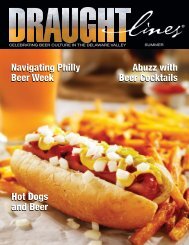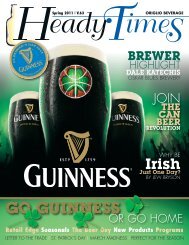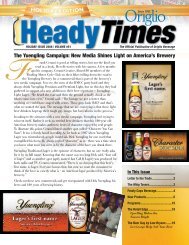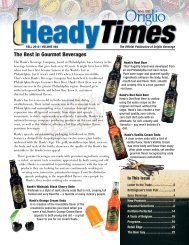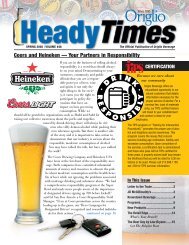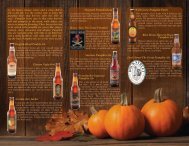Volume 3 | Issue 1 - Origlio Beverage
Volume 3 | Issue 1 - Origlio Beverage
Volume 3 | Issue 1 - Origlio Beverage
You also want an ePaper? Increase the reach of your titles
YUMPU automatically turns print PDFs into web optimized ePapers that Google loves.
THE<br />
AMERICAN<br />
INDUSTRY:<br />
A Classic “Come-from-Behind” Victory<br />
By Steve Hawk, Philly Beer Geek 2010<br />
Beer was destined to be the alcoholic beverage of choice in America.<br />
We inherited this tradition from our earliest settlers from England who<br />
loved their ale and strengthened our bond with the beverage in the 19th<br />
century when a new influx of German immigrants introduced the lager<br />
style to our nation.<br />
The beer produced in America at that time was different from its European<br />
counterparts. It was made from America’s six-row barley, as opposed to<br />
the two-row variety available in Europe. The grain mixture was adjusted<br />
by adding up to 30% corn to the barley malt mash, but it was brewed to<br />
full-fledged European strength, yielding a full-bodied and slightly sweeter<br />
beverage. By the early 20th century, there were about 1,400 breweries<br />
operating in the U.S. and Americans of every walk of life were enjoying<br />
their beer. Then the unthinkable happened.<br />
In 1920, the U.S. Congress passed the 18th Amendment banning the<br />
sale, manufacture and transportation of alcohol. Every brewery closed<br />
its doors, except the few that began manufacturing “Near Beer” or other<br />
beverages. Prohibition continued until 1933. It was a devastating blow to<br />
America’s beer industry.<br />
Recovery from this 13-year dry spell was slow and further impacted by<br />
the start of World War II. When America entered the War in 1941, the<br />
beer industry had still not fully recovered, plus brewers faced the added<br />
challenge of having to use ingredients that were not limited through<br />
rationing.<br />
Most breweries, therefore, used less barley and added rice as a filler.<br />
This lightened the flavor of the beer, making it more appealing to the new<br />
female consumers. After the war ended, the process was not substantially<br />
changed. To this day, much of the beer consumed in America still<br />
follows that same style.<br />
There was, however, a breakthrough in the beer industry in 1978 that<br />
added a whole new dimension to beer consumption. The U.S. Congress<br />
passed an act signed by President Carter exempting home brewed beer<br />
from taxation, and thereby, encouraging the practice of homebrewing.<br />
Beer drinkers who craved more exotic flavors now had the option of<br />
brewing it themselves and homebrewing became a very popular hobby.<br />
A few homebrewers were so successful they eventually expanded their<br />
operations. Before long, hundreds of small breweries and brewpubs<br />
sprang up across the nation, producing beer for its distinction and flavor<br />
rather than mass appeal. This new genre of beer soon became known<br />
as “craft beer”.<br />
No one could have imagined the excitement this phenomenon would<br />
generate. Beer went from being a beverage to a full-blown culture. In<br />
2004, the craft beer industry was featured in a documentary film called<br />
American Beer. Additionally, “Beer Week” celebrations and other events<br />
started popping up all over the country. The number of microbreweries<br />
skyrocketed and the popularity of America’s beer culture was evinced<br />
by beer-themed magazines, home brew clubs and internet websites. I,<br />
myself, am a product of this enthusiasm, as I proudly hold the title of<br />
Philly Beer Geek 2010.<br />
Of course, all of this excitement couldn’t possibly be contained on this<br />
side of the Atlantic. So it begs the question, how does this new trend play<br />
out in the beer drinking tradition of Europe, where our ancestors came<br />
from<br />
The fact is, demand for America’s beer is high overseas, but importing<br />
costs are very expensive and the price tends to scare off importers, bars<br />
and shops. Additionally, European breweries are less likely to brew craft<br />
beer themselves. Brewing traditions and regulations, like Germany’s<br />
Reinheitsgebot (the Purity Law which limits beer to only four main ingredients),<br />
make it difficult for brewers to be creative. Nevertheless, some<br />
European breweries, particularly in Denmark and Norway, are crossing<br />
the line to emulate their American counterparts by using American hops<br />
and American styles of brewing. Also, Stone Brewing Company, based<br />
in Escondido, California, plans to be the first American craft brewery to<br />
construct a facility in Europe.<br />
Obviously, the stigma of America’s Prohibition era is long past. Beer is<br />
the most popular alcoholic beverage in America today and Europe is<br />
eyeing us with envy. That’s quite a comeback for a product that was<br />
banned for more than a decade. I personally have been cheering from<br />
the sidelines since I took my first sip of my grandfather’s brew. It feels<br />
good to back a winner!<br />
3




